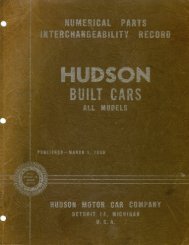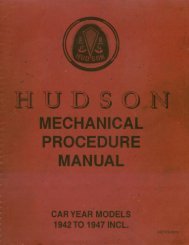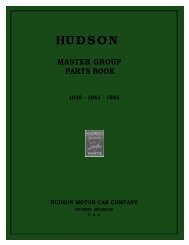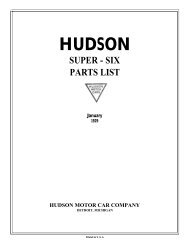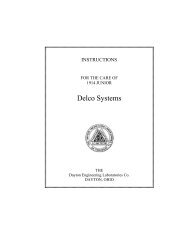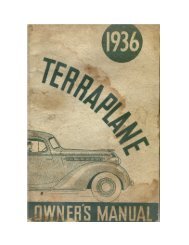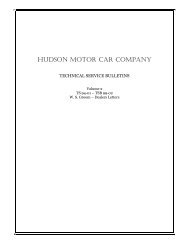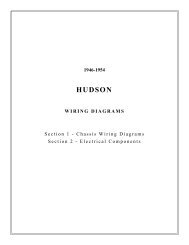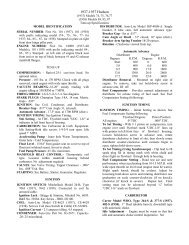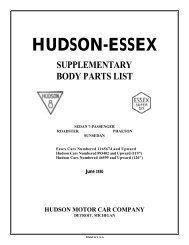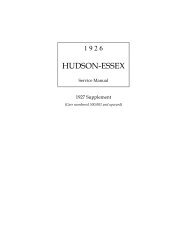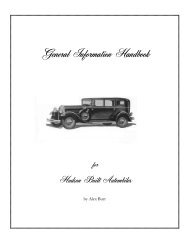1948-1952 Shop Service Manual - - Hudson-Essex-Terraplane Club
1948-1952 Shop Service Manual - - Hudson-Essex-Terraplane Club
1948-1952 Shop Service Manual - - Hudson-Essex-Terraplane Club
Create successful ePaper yourself
Turn your PDF publications into a flip-book with our unique Google optimized e-Paper software.
7 - 6 CLUTCH<br />
2. Driving plate should run true at cork faces within .010"<br />
when rotated on Vee blocks with mandrel inserted in hub<br />
spline.<br />
3. Hub splines must be free of burrs and nicks and must slide<br />
freely on splines of main drive gear (clutch shaft) without<br />
appreciable backlash.<br />
4. Examine spring loaded hub for broken springs or stampings.<br />
Spring cages should retain the hub in the plate<br />
without appreciable angular backlash or sidewise lost<br />
motion and springs should be a tight fit with no clearance<br />
between ground ends of springs and clutch inner driven<br />
disc to insure proper frictional load between inner and<br />
outer driving plates.<br />
Plates that do not meet above specifications should be<br />
replaced.<br />
PRELIMINARY COVER CHECK<br />
Before proceeding with disassembly of cover and pressure<br />
plate assembly, check for general condition of cover, fingers and<br />
retainers. This test should be made regardless of whether the<br />
pressure plate appears to be in good or bad condition.<br />
1. Mount the pressure plate and cover assembly on base plate or on<br />
a standard flywheel with a standard driving plate a n d ONE<br />
standard gasket interposed.<br />
2. Bring cover into firm contact with flywheel or base plate using an<br />
arbor press or other means, then Install and tighten 8 of the 16<br />
cover-to-flywheel cap screws.<br />
The measurements described in the next paragraph should<br />
always be made with the cover held to base plate or flywheel at<br />
the front flange, not at the hub or rear wall of the cover.<br />
3. Using a machinists combination square or depth micrometer,<br />
measure the distance from clutch throwout<br />
bearing contacting surface of lowest finger to top of<br />
cover hub (A) as shown in Figure 6. On a clutch in<br />
good condition, the distance should be 1-1/4" to<br />
1-1/2" when the interposed driving plate is .200" to<br />
.213" and the gaskets are .028" to .032" uncompressed<br />
thickness.<br />
If distance is greater than 1-1/2" the throwout fingers<br />
and/or retainers are excessively worn or the cover is<br />
distorted inwardly. The assembly should be disassembled<br />
for inspection of its component parts.<br />
If distance is less than 1-1/4", it can be assumed that<br />
the fingers, cover and retainers are not excessively worn<br />
and further disassembly is optional except for testing the<br />
pressure of the engaging springs or replacing the pressure<br />
plate. It can be assumed as satisfactory, providing fingers<br />
clear hub of cover by at least 1/8".<br />
PRESSURE PLATE :<br />
NOTE: Before proceeding with disassembly of the cover<br />
and pressure plate assembly, look for the correlation<br />
punch mark near the outer edge of the pressure plate and<br />
a corresponding mark near it on the cover flange. These<br />
marks indicate the relative position of the parts when the<br />
assembly was balanced at the factory and the marks<br />
should be kept together to maintain the original balance.<br />
Use a press to compress the engaging springs. With spring<br />
load relieved, remove the 3 nuts from back of cover and<br />
remove the cover, springs, fingers, finger retainer and sealing<br />
washers.<br />
FIGURE 6<br />
Pressure plate should be free of cracks, burns or scores and<br />
should be true within .010". Scrape all gummed oil from<br />
pressure plate. Warpage may be readily checked by laying<br />
pressure plate on a surface plate. If a .010" feeler can be<br />
inserted at any point between surface plate and pressure<br />
plate, the pressure plate should be replaced. If a surface plate<br />
is not available, use a new pressure plate or flywheel to serve<br />
as a surface plate.



